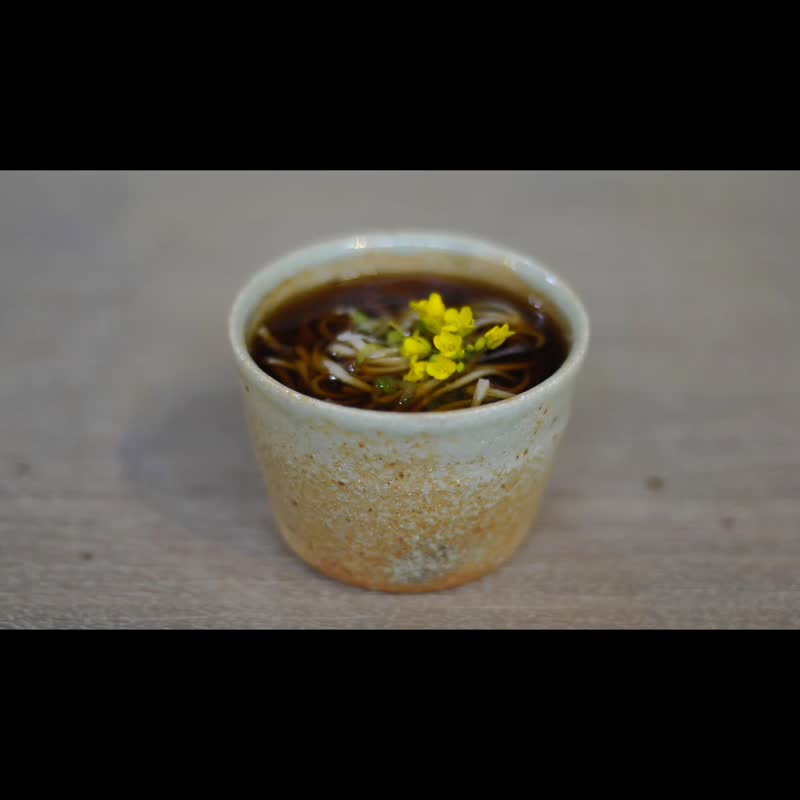This buckwheat cup is a yohen (*1) pottery made by molding on a potter's wheel. Each one is slightly different in shape and texture. The soba choko cup used when eating Japanese soba is also used for other food and drink purposes such as sake and tea in Japan. Since it is a container that is used when eating soba, it has a large capacity, so it is good to use it as a rocks glass when drinking whiskey. I want you to enjoy the natural texture of the tropical white sandy beach and the sea.
Anyone can bake in a wood-fired kiln.
Everyone is unable to manipulate hi to draw out the potential of the soil and create a "scenery" consisting of "sesame", "scarlet", "sankiri", "vidro" and "burnt". Hokekyoan continues to take on the challenge of this difficult task.
The level of kiln change is ★3.
Each one has a different texture, but they have 3 out of 5 kiln transformation elements. I will deliver 3 items from the ones in the same atmosphere in the photo.
■■ Thoughts on this style ■■
Ever since I was a child, I have longed for the "southern seas" such as Hawaii and Okinawa. Even now, I long to move to places with beautiful seas such as “Tahiti”, “Palau”, “Kenting” in Taiwan, “Phuket Island” in Thailand, and “Cebu Island” in the Philippines.
When I was 22 years old and lived in Tokyo, I traveled with some friends to Shizuoka Prefecture, where "Mt. Fuji" is located. About two and a half hours from Tokyo on the Odoriko express train, I was surprised and moved to find the Teal sea that I had dreamed of since I was a child.
At the age of 35, when I started making pottery, I visited this sea again, and tried to “reproduce” the excitement of that time by copying it into “pottery”.
■■Yohen = Allowance of chance=Natural style■■
"Elements of the tropical sea" shallow sandy beaches, white sandy beaches, foamy beaches, Teal waves. The dazzling sun, this is a pottery that tries to reproduce these elements in a limited modeling space called "vessel". In terms of traditional Japanese pottery styles, it refers to ``sesame'', ``scarlet'', ``sankiri'', ``vidro'', and ``charred''. .
■■ Wabi Sabi = Growing up = Aging ■■
Japan's climate and climate are high in humidity and not ideal for "things". Sen no Rikyu's "Wabi-Sabi" is the answer to such a bad situation, which he nurtured with his wise worldview. All things will decay and return to the earth. Putting ourselves in this world for a while, how we "exist" in the world reflects our "mind" in dealing with things. The work we delivered is an "unfinished living pottery" whose cracks (penetration) and dirt (plum blossom skin) seeps in the more it is used, and which is used and maintained to create a tasteful atmosphere. * In Japan, there is an evaluation that things are “tasteful”. The original meaning of this alludes to the "personality of the user" of "how it was used" and "how it was raised". Touch the heart of "Wabi-Sabi", which transforms even the contradictory concept of "be clean and dirty" into beauty, and complete it with your own hands to create a special gem just for you.
■■ “Management innovation” promoted by “Ministry of Economy, Trade and Industry” ■■
Hokekyoan's pottery has been certified as a "management innovation" promoted by the Ministry of Economy, Trade and Industry of Japan.
I use a unique technique called "pointillism hanging" and "extreme reduction oxidation removal".
This "title" is given to "techniques and techniques" rather than "things".
■■Product standards and manufacturing methods■■
Material Pond bottom soil + Shirahama sand = original blended soil
Technique potter's wheel sawing
Size about 9cm in diameter X 7cm in height
Weight about 150 grams
Capacity about 200cc
Yohen Level ★★★☆☆
■■Explanation of kiln transformation level■■
There is no same thing as one, and although it is my subjectivity, it represents the atmosphere of the kiln transformation level.
Please use it as an indicator when purchasing.
★☆☆☆☆ This item will not be sold ➔ I will make it again
★★☆☆☆ Partially scratched and can't be expected to improve even after re-firing, but it's a shame to break it ➔ Wagon sale
★★★☆☆ Yes, it feels good.
★★★★☆About 5-10% per kiln firing➔Give it as a gift or treat yourself
★★★★★ 0 to 2 per kiln is good level One item (excellent item) ➔ Sold on individual page
■■※1 Explanation of the pottery of "Yohen" ■■
It boasts hundreds of years of history as a Japanese pottery that values its natural texture. Even with the same baking, each one has a different personality. It is said that uncalculated and unexpected factors, such as the location in the kiln, the season, atmospheric pressure, soil and fire, and other mysterious chemical changes caused by chance, produce a single piece of art as a result. The spirit of craftsmanship, which allows for chance, is gaining recognition and admiration for its style reminiscent of the mountains and rivers of nature.
รายละเอียดสินค้า
ข้อมูลสินค้า
- วัสดุสินค้า
- ดินเผา
- วิธีการผลิตสินค้า
- แฮนด์เมด
- แหล่งผลิตสินค้า
- ญี่ปุ่น
- จุดเด่นของสินค้า
- ได้รับรางวัล, จำหน่ายเฉพาะบน Pinkoi
- อันดับสินค้า
- No.1,312 - เครื่องใช้ในครัว | No.26 - ถ้วยชาม
- ความนิยม
-
- ถูกชม 2,148 ครั้ง
- จำหน่ายไปแล้ว 1 ชิ้น
- มี 7 คนถูกใจ
- สินค้าที่จำหน่าย
- สินค้าต้นฉบับ
- รายละเอียดย่อยของสินค้า
- This is a pottery of "Yohen" and "Wabisabi". Even the same product has a different character. The location in the kiln, the season, air pressure, soil and fire, and other mysterious chemical changes caused by randomness, uncalculated and unexpected factors give rise to a single piece of art as a result.
ค่าจัดส่งและรายละเอียดอื่นๆ
- ค่าจัดส่ง
- วิธีชำระเงิน
-
- บัตรเครดิต/เดบิด
- อินเตอร์เน็ตแบงก์กิ้ง/โมบายแบงค์กิ้ง
- เคาน์เตอร์เซอร์วิส
- ตู้เอทีเอ็ม
- เคาน์เตอร์ธนาคาร
- Alipay
- การคืนเงินและเปลี่ยนสินค้า
- อ่านรายละเอียดการคืนเงินและเปลี่ยนสินค้า
- แจ้งปัญหา
- รายงานสินค้าชิ้นนี้










